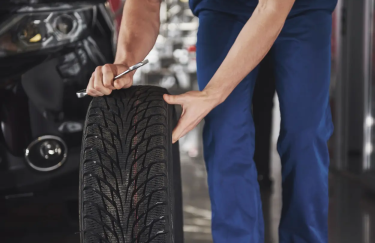-

Tetyana Yermolenko
Correspondent

Rubber before November 1: what does the law say and when is it really time to “change shoes”?
As chilly autumn days arrive, a multitude of Ukrainian vehicle operators find themselves contemplating a crucial inquiry: when should one switch from summer to winter tires, and are there penalties for failing to do so? While this question may appear straightforward initially, it necessitates a thorough and well-considered approach.
The precise, prime moment for replacement hinges not solely on the calendar but also on actual ambient temperature, prevailing road conditions, the region of residence, and even the driver’s unique manner of operating the vehicle. The Delo.ua team has undertaken a detailed analysis of the legal stipulations and expert advice related to making the change to winter tires.
Why swapping tires with the seasons is of utmost importance
It’s key to comprehend that summer tires and winter tires differ not merely in their observable tread design but also in the comprehensive internal structure and chemical formulation of the rubber blend, which directly influences the degree of grip on the roadway.
During the summer months, the rubber substance is uniquely crafted for elevated temperatures, maintaining its required suppleness even when temperatures soar to +30-35°C. Conversely, in frigid conditions, such a tire becomes critically rigid, “hardens,” and practically forfeits its ability to adhere to the asphalt.
By contrast, winter tires are developed using a distinctly contrasting method designed for low temperatures, affording dependable braking even on icy surfaces, snow-covered roads, or damp asphalt when temperatures plummet below zero.
What is the stance of Ukrainian laws regarding winter tires?
A significant number of motorists are concerned about the question: when is it legally permissible to transition from summer to winter tires in Ukraine, and are there imposed penalties for non-compliance with the established deadlines? The state of Ukrainian legislation presents its own unique set of attributes.
As of November 2025, neither the Road Traffic Regulations nor the Code of Administrative Violations in Ukraine contains an article that explicitly and unequivocally stipulates when tires must be switched to winter tires while specifying exact calendar dates.
The sole legislative standard is outlined in subparagraph 31.4.5 of the Traffic Laws, which suggests fitting tires that align with the present state of the road’s surface (rain, snow, frost, ice). In essence, the phrasing remains notably ambiguous, permitting considerable interpretation. However, a fine may be issued for the following:
- insufficient tread depth : measuring less than 1.6 mm for vehicles weighing up to 3.5 tons;
- physical damage to tires : encompassing cuts, bulges, and peeling of the rubber compound;
- size incompatibility : where the load rating fails to correspond with the vehicle’s weight;
- dissimilar tires on a common axle : involving variations in size or build (radial versus bias-ply);
- combinations of studded and non-studded tires : mixing studded tires on certain axles with standard tires on others.
For fitting wheels that fall short of these technical prerequisites, the vehicle owner is subject to an administrative fine under Article 121 of the Code of Administrative Offences , amounting to between 340 and 680 hryvnias. Should a repeat offence occur within a year, the driver may forfeit their license for a period spanning 3 to 6 months or be subjected to up to 10 days of administrative detention.
Proposed legislation on obligatory winter tires: what’s being contemplated
The Verkhovna Rada is weighing draft legislation No. 4373 , which suggests a radical alteration to the existing landscape by introducing explicit sanctions for operating a vehicle on summer tires during the winter months.
As per the draft document, drivers could face fines of 1,700 hryvnias for the primary infraction of the regulations concerning the switch to winter tires . Subsequent violations within a single year may result in a far stricter penalty: a fine ranging from 3,400 to 8,500 hryvnias, coupled with a simultaneous suspension of driving privileges for 3 to 6 months.
While the bill has yet to be enacted and remains a subject of deliberation, its ratification holds the potential to fundamentally reshape how Ukrainian drivers approach the subject of seasonal tire changes .
When experts advise changing tires: temperature benchmark
Experts in the automotive sector and tire manufacturers widely concur that when transitioning from summer to winter tires , the primary focus should be on prevailing weather conditions and temperature readings, rather than adhering strictly to calendar dates.
The pivotal, scientifically corroborated indicator for decision-making is a sustained average daily air temperature below +7°C for a series of consecutive days. It is at this critical juncture that the chemical composition of the summer rubber blend loses its suppleness and essential softness, leading to a substantial decline in road grip.
The determination of when to proceed with the exchange from summer to winter tires also depends on the specific type of tires selected: friction (often referred to as “velcro”), studded, or adaptable all-season varieties. Studded tires may require a slightly earlier fitting, as the metal studs offer vital supplementary traction during initial frosts and when encountering a slender coating of ice.
Moreover, seasoned specialists earnestly advise against postponing the tire replacement procedure until the final days preceding frost, as queues at tire fitting locations conventionally lengthen throughout October and November, with service fees escalating by 1.5-2 times.
Optimal replacement periods across various regions in Ukraine
The most suitable timeframe for tire changes varies considerably, depending on the geographical location and climate-related attributes of a given area within Ukraine.
For northern and central regions (Kyiv, Chernihiv, Sumy, Zhytomyr), it is generally advisable to transition from summer to winter tires between October 15 and November 5, as the mean daily temperature consistently dips below +7°C.
In western and mountainous regions (Lviv, Ivano-Frankivsk, Transcarpathia, Chernivtsi), given the earlier incidence of frosts and the challenges presented by the terrain, it is prudent to switch your car’s tires in late September or early October, particularly if you intend to journey into mountainous areas.
Within the southern regions (Odessa, Kherson, Mykolaiv, and parts of Dnipropetrovsk), it is acceptable to defer the conversion to winter tires until mid-November, particularly if the roadways remain clear and night temperatures do not fall below +3-5°C.
How to recognize when it’s time to change your tires
In addition to monitoring ambient air temperature, other practical signs can alert drivers to the need for an urgent replacement to winter tires :
If the tread pattern of a summer tire starts to lose its distinct contours, and the measured depth of the grooves diminishes below the minimum permitted range of 3-4 mm, the tire’s grip on damp surfaces and during rainfall is significantly reduced.
When summer tires grow notably hard in the face of morning frosts, braking distances automatically extend, and the likelihood of experiencing skidding or sliding, even at a moderate velocity of 50-60 km/h, multiplies several times compared to warmer conditions.
Consequently, should you observe that your vehicle responds more sluggishly to applying the brake pedal or the precision of steering when cornering diminishes, this constitutes a clear indicator: it is imperative to change your tires promptly .
European practices: how these issues are addressed in other countries
The rules and regulations across European nations typically govern the utilization of winter tires with far more rigor compared to Ukraine, striving to maximize road safety throughout the colder months. Distinct EU countries impose unique stipulations and prerequisites concerning mandated tire changes .
- Germany : Requirement to use winter tires when facing snow, slush, or ice on the roadways, without stipulating precise dates.
- Austria : Strict enforcement from November 1 to April 15 across all winter weather scenarios.
- Finland : Compulsory from December 1 through the end of February for all vehicles, no exceptions.
- Czech Republic : From November 1 to March 31, when temperatures remain consistently below +4°C.
- Poland : Formally advised but not legally enforced.
- Sweden : From December 1 to March 31, strictly required, potentially leading to fines for non-compliance.
- Norway : From November 1 to April 15, with spiked tires compulsory in the northernmost regions.
These profound variations relate directly to climatic conditions; within Scandinavian countries, where the winter season persists longer and exhibits greater severity, the legal framework governing tire replacement is much more stringent, carrying substantial penalties for transgressions.
Typical mistakes made by Ukrainian motorists
Numerous domestic vehicle owners consistently make common and potentially hazardous errors rooted in a lack of complete understanding regarding when to transition from summer tires .
Changing tires too late
Drivers often wait for the occurrence of the first major snowfall or icy conditions, despite summer tires objectively losing a significant portion of their efficacy when temperatures decline below +5°C.
Using winter tires in summer
Such softer rubber compounds wear out more swiftly and unevenly at warmer temperatures, notably impairing the vehicle’s handling at higher speeds and causing a 5-10% increase in fuel usage.
Improper installation
Disregarding the designated direction of rotation or equipping tires featuring different wear levels on the same axle promotes uneven tread erosion and diminishes handling responsiveness.
Ignoring balancing
The omission of wheel balancing after seasonal tire replacements contributes to vibrations at speed, expedited wear of suspension components, and an unpleasant experience during operation.
Practical recommendations from experts on preparing for winter
Seasoned auto technicians and specialists from within the tire sector uniformly suggest launching preparations in anticipation of the winter season well in advance, rather than delaying until the eleventh hour.
Commence by verifying the true depth of the tread, utilizing a designated gauge. A minimum of 4 mm is required for winter tires to provide effective traction on icy and snow-blanketed surfaces.
Then, diligently ensure that the entire set of wheels adheres to the size specifications, load rating, and velocity index guidelines as recommended by your vehicle’s manufacturer.
If employing studded tires, allow them adequate time to bed in properly during the initial 300-500 kilometers. Refrain from traversing highways at increased speeds exceeding 80-90 km/h immediately post-installation, as this could potentially damage or dislodge the newly affixed studs.
Furthermore, regularly monitoring the condition of the rubber mixture is essential. If the rubber becomes excessively rigid, loses its elastic characteristics, or exhibits cracks, it is preferable to err on the side of caution and procure a fresh set of tires.






